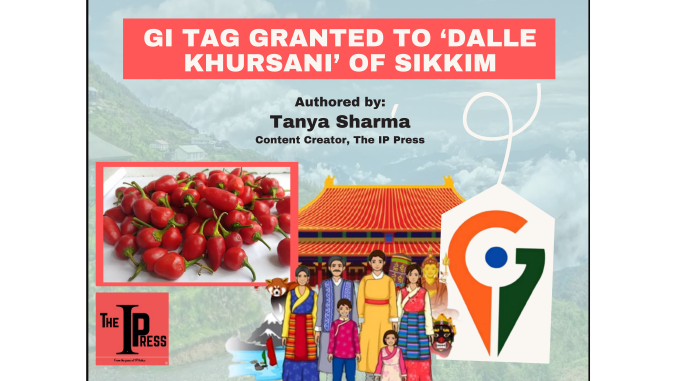
“Dalle Khursani” of Sikkim has been recently granted a GI Tag. This is the second GI Tag awarded to Sikkim. Dalle Khursani is an agricultural product, whose application for a GI tag was filed by North Eastern Regional Agricultural Marketing Corporation Limited (NERAMAC) on 10th December 2018 and the product was certified on 14th September 2021 [click here to read all documents]. The Application Details of “Dalle Khursani” are mentioned below-
Application Details
| Application Number | 636 |
| Geographical Indications | Dalle Khursani |
| Status | Registered |
| Applicant Name | North Eastern Regional Agricultural Marketing Corporation Limited (NERAMAC) |
| Applicant Address | 9, Rajbari path, Ganeshguri, G. S. Road, Guwahati, Assam, India, 781 005 |
| Date of Filing | 10/12/2018 |
| Class | 30 |
| Goods | Agricultural |
| Geographical Area | Sikkim |
| Priority Country | India |
| Journal Number | 144 |
| Availability Date | 31/03/2021 |
| Certificate Number | 414 |
| Certificate Date | 14/09/2021 |
| Registration Valid Upto | 09/12/2028 |
Red Cherry Pepper (Capsicum annum var cerasiforme), locally known as Dalle Khorsani in Sikkim; is well known for its unique flavor and high pungency. The Scoville score for this chilli is rated in the range of 100,000 to 350,000 SHU (Scovelle Heat Units). It is one of the valuable cash crops and is grown all over the state since it is valued for its diverse commercial uses. It is a perennial crop characterized by small to medium sized pods. Dalle Khorsani is almost round cherry size and bright red when fully ripe and is known to be one of the hottest chillies in the world. It is used in multitudes of food preparations and marketed in different regions. Fruits are also used in making pickle, paste, powder, and dry chilli. The high flavor is the unique characteristic of this chilli. Besides capsaicin which produces pungency, it contains carotenoids and phenolic compounds and is being used as natural pigment and anti-oxidant agents. This chilli has also many medicinal properties.
Dalle Khorsani belongs to the family ‘Solanaceae’ and genus ‘Capsicum’ and is grown up to 100-130 cm height under open field and 150-180 cm height in green house condition and is grown and widely consumed in Sikkim, Nepal and the entire eastern Himalayan belt. It is high in Vitamin A, Vitamin E, and Potassium, and low in Sodium. One hundred grams of fresh red chilli pepper has 240 mg of Vitamin C (five times higher than an orange), 11,000 IU of Vitamin A, and 0.7 mg of Vitamin E. Vitamin C is sensitive to heat and drying but Vitamin A is very stable, and paprika and dried chilli both contain relatively high amounts of this important nutrient.
Peppers are well-known for their health benefits. Herbalists have long promoted peppers for their health enhancing effects. These include clearing the lungs and sinuses, protecting the stomach by increasing the flow of digestive juices, triggering the brain to release endorphins (natural painkillers), making the mouth water, which helps to neutralize cavity-causing acids, and helping protect the body against cancer through antioxidant activity.
Being very addictive, this chilli is a favourite side-dish with the usual ‘daal-bhaat’ in the Nepal-Sikkim belt. Commonly used for chutneys and sauces along with momos, it is regularly consumed in winters as it keeps the body warm. Giving the sweet-tingly taste, Dalle has now become a very widely used chilli in the North Eastern regions of India due to its addictive taste. It is also eaten with rice alone in many villages of Sikkim to cancel out the intense heat.
There are many homemade recipes using Dalle Khorani namely Chicken Chilli, Dalle achaar etc. but the most infamous one of them is the fermented Dalle along with yak-buttermilk (also known as soft churpi). The most commonly used form of it is the fermented pickle. From pickles to pizzas, inhabitants keep experimenting with food using it. The popular red chutney accompanying momos most popularly uses this chilly. Dalle is now so popular with foreign tourists that the Sikkim Government encourages the growth of Dalle for exports also.
Lastly, Dalle Khorsani can be grown all the year round under protected condition and is grown completely in organic way of cultivation. It continues to bear fruits for 2-3 years and normally 4-5 picking are done every year, thus, supply of the chillies is continuous.
Click here to read further about ‘GI Tags of Sikkim’:

Leave a Reply